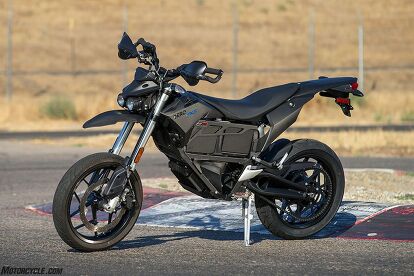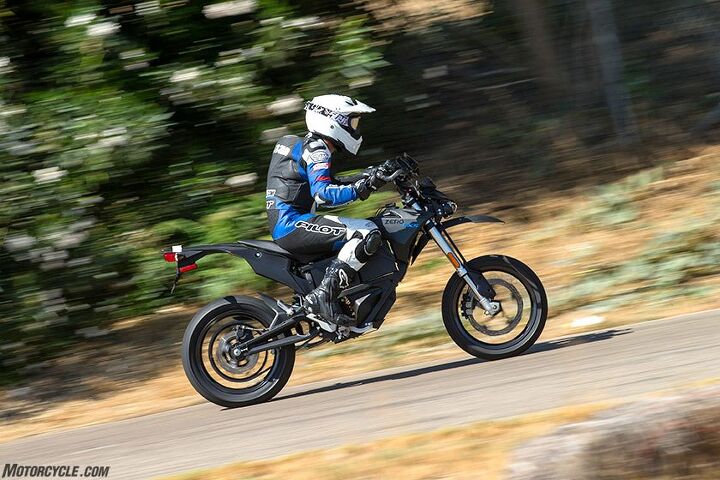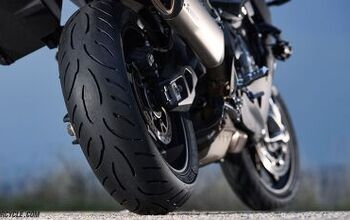Putting The Zero FXS To The Test On Track

Is the new IPM motor really that much better?
Remember that time, two years ago in 2014, when we put an electric bike up against an ICE motorcycle… and the electric won? The two protagonists in that matchup were the Zero FX, modified for supermoto use by our friend Harlan Flagg, proprietor of Hollywood Electrics, and the Suzuki DR-Z400SM. At that time Zero had yet to officially have a supermoto version of its FX in the lineup, but other than the obvious change in wheels, brakes, and tires, the FX was otherwise a stock bike.
Both Tom and I were really impressed with the Zero’s performance at Adams Motorsports Park, the Zero every bit the match for the Suzuki in the corners, and its superior torque allowed the electric to dust the gas burner coming out of them. However, the Zero’s major flaw was the fact that superior performance was only sustainable for a few hot laps, after which the FX’s surface-mount motor would start to overheat and thermal cutback would kick in, severely neutering its performance and allowing the DRZ to claw back some ground. It was the classic tortoise-and-hare situation.
Fast forward to the start of 2016 and the launch of two new Zero models: the DSR and FXS. The launch was also significant as it was the first chance to try a new motor design incorporated into both bikes (and most of the Zero lineup): the Z-Force IPM (Internal Permanent Magnet) motor. An all-new, patent-pending motor design, the IPM basically buries the magnets inside the rotor, moving them away from the stator, and thus reducing the amount of heat the magnets are exposed to. The rotor itself also acts as a heatsink, and its shape is slightly wavy instead of being perfectly round, which provides a slight cooling effect. You can learn more about the IPM motor by reading the DSR review, or by watching this thorough explanation by Zero’s Director of Powertrain Engineering, Ryan Biffard. What I wanted to know was whether it overheats and how it would react if it did.
Be Careful What You Wish For
Recently I had the opportunity to sample the FXS in an extreme environment to discover those answers for myself. Adams Motorsport Park in Riverside, California is a tight and twisty kart track, and is also the same location we performed our gas vs. electric shootout. The track setting itself would provide the kind of punishment for the FXS that I couldn’t accomplish on the street ride during the bike’s intro, but to up the ante a bit, ambient temperatures were in the triple digits (that’s Fahrenheit for our international readers), making this an extreme test for both man and machine.
There’s no point boring you with details about the FXS’s handling characteristics; we’ve covered the FX platform so many times one simply needs to type it in the MO search bar to find out. The purposes of this test centers around the IPM motor, its power, and how it copes with heat. However, here are some key points to keep in mind: the FX ZF3.3 (only one battery pack) costs $8,495, before a $850 federal tax credit. Meanwhile, the ZF6.5 (two battery packs) will set you back $10,990 before an $1,100 federal tax credit (check the Zero website for any state credits where you live). Both models come with fully adjustable 41mm Showa suspension bits at both ends, and a single 320mm disc up front mated to a J-Juan two-piston caliper. Steel-braided lines and Bosch ABS come standard.
Despite the new motor, power output hasn’t changed with the IPM. There’s still 44 hp and 70 lb-ft available to push around the 292-pound (claimed) FXS, and it does so briskly. Acceleration is the strongsuit for the Zero line, and my butt dyno estimates you’d have to have a well-sorted and built 450 to match the eagerness to which the FXS darts forward. Using Zero’s smartphone app, at the push of a button the bikes were dialed for maximum power and maximum regenerative braking, the latter to allow the journos on hand who hadn’t ridden an electric before to experience a sort of engine braking effect they’re familiar with on ICE machines.
A byproduct of upping the regenerative braking is excess heat. According to Sean McLaughlin, Zero Product Marketing Manager, the Zero software regarding heat management had not been changed for the IPM motor from the previous surface-mount motor, meaning thermal cutback warnings on the dash (a blinking thermometer icon) activate at the same threshold of 100º C. The light turns solid and the fun really starts to wind down at 140º C.
Throughout the course of our sessions I did notice the blinking light on the dash, but I wasn’t paying close attention to when they turned on because I was still having a good time riding. It took me a few sessions to realize this was because the thermal cutback isn’t nearly as pronounced as before. In regard to power degradation at the limits of thermal capacity between the old surface mount and the new IPM, it’s a night-and-day difference. The IPM is simply leaps better. McLaughlin says this improvement in sustained performance is because the IPM produces less heat to begin with and manages the remaining heat better than before.
Yes, I did still feel a slight drop-off in power, but it didn’t spoil the fun. In fact, on our hot test day, I overheated before the bike did. If I were to assign percentages to the level of drop-off, if the previous surface mount motors cut back to 50% power to manage overheating, then the IPM motor only drops to 80%. That’s the difference I felt from the saddle.
Simply put: I’m impressed with the Z-Force IPM motor. More than just vaporware or marketing mumbo jumbo, this is a noticeable step forward compared to the technology it’s replacing. As far as performance killers go, heat is the number-one enemy for both ICE and electric propulsion, and although Zero hasn’t completely tamed the beast, it has reined him in significantly with the IPM motor.

Troy's been riding motorcycles and writing about them since 2006, getting his start at Rider Magazine. From there, he moved to Sport Rider Magazine before finally landing at Motorcycle.com in 2011. A lifelong gearhead who didn't fully immerse himself in motorcycles until his teenage years, Troy's interests have always been in technology, performance, and going fast. Naturally, racing was the perfect avenue to combine all three. Troy has been racing nearly as long as he's been riding and has competed at the AMA national level. He's also won multiple club races throughout the country, culminating in a Utah Sport Bike Association championship in 2011. He has been invited as a guest instructor for the Yamaha Champions Riding School, and when he's not out riding, he's either wrenching on bikes or watching MotoGP.
More by Troy Siahaan






































Comments
Join the conversation
Sounds like a huge step forward, I would really enjoy a test ride on one!
I have been considering a DRZ400SM and I am wondering if this would make
a suitable alternative and what my charging logistics would be. How long (in minutes) were you able to ride with a single pack before needing to recharge? Or rather, what % of you battery was consumed by a 20(?) minute session on the track?